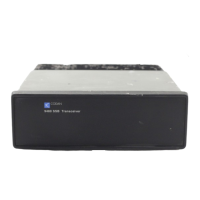Using selective call
9480 HF SSB transceiver 5-17
Receiving a selective call
Step Action… Display shows… Remarks…
1.
No action. The
transceiver
automatically
completes this
event.
When you receive a call
the display changes to
show you the self-
identification address of
the calling station.
When you receive a call,
you hear tones.
You hear a series of three
telephone rings for
selective calls, and 16
short ‘beeps’ for group
calls.
Notes: On receipt of a call you have two options:
• either answer it immediately. Refer to page 5-18, Answering a
received call
• let the transceiver automatically store the caller’s self-identification
number in memory to await your reply, refer to page 5-19, Returning
a received call.
If your transceiver was unattended at the time the selective call was
received, the callers self-identification number is stored in memory for
you to review at a later time. Refer to page 5-20, Reviewing the list of
received calls in memory.
If you do not answer the call immediately, once the call is stored in
memory your transceiver continues to emit ‘pips’ every four seconds to
indicate that a call has been received. If you wish to silence these ‘pips’
yet still retain the display, press the ‘Disp’ button.
If you only wish to receive selective calls, ensure the S’Call Mute
indicator is lit.
If the microphone PTT button is not pressed before the end of the tones:
• the called display remains on to indicate that a call was received
• a ‘pip’ is heard every four seconds
• the external alarm relay contacts close for approximately two
minutes (refer to page 5-29, Using the external alarm feature).
q

